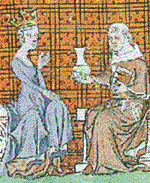The
University is one of the foremost places in the United States
for medieval studies. Here's why.
 Assistant
professor of history
Rachel Fulton is trying to discern exactly what caused a marked
shift in early Christians' views of Christ. In her sixth-floor
office in Harper Tower, surrounded by medieval motifs, she searches
for clues in the writings of 11th- and 12th-century church theologians
such as Anselm of Canterbury and Peter Damian.
Assistant
professor of history
Rachel Fulton is trying to discern exactly what caused a marked
shift in early Christians' views of Christ. In her sixth-floor
office in Harper Tower, surrounded by medieval motifs, she searches
for clues in the writings of 11th- and 12th-century church theologians
such as Anselm of Canterbury and Peter Damian.
 The
shift, she explains, occurred around the turn of the first millennium.
Before that time, pious Christians prayed to Christ as the all-powerful
King of Heaven rather than as the man who had died a humiliating
death. According to many early church authorities, the crucified
Christ was an image not of reassurance but of judgment. In their
view, when Christ came to judge the living and the dead at the
end of time, only the damned would see him emblazoned with his
wounds. Shortly after the millennium, however, this image began
to change. By the mid-11th century, some Christians began to meditate
on Christ at the moment of the Crucifixion. Once avoided as an
image of damnation, the crucified Christ would become the central
symbol of later medieval Europe.
The
shift, she explains, occurred around the turn of the first millennium.
Before that time, pious Christians prayed to Christ as the all-powerful
King of Heaven rather than as the man who had died a humiliating
death. According to many early church authorities, the crucified
Christ was an image not of reassurance but of judgment. In their
view, when Christ came to judge the living and the dead at the
end of time, only the damned would see him emblazoned with his
wounds. Shortly after the millennium, however, this image began
to change. By the mid-11th century, some Christians began to meditate
on Christ at the moment of the Crucifixion. Once avoided as an
image of damnation, the crucified Christ would become the central
symbol of later medieval Europe.
"This
image came into being at a particular point in European history,
and it was refined and developed for centuries thereafter," says
Fulton. "It survives in altered form today in the continuing search
for the human, historical Jesus, and it was, I would argue, at
the root of the development of modern methods of historical criticism."
Fulton,
who joined Chicago's faculty in 1994, is one of many scholars
across campus who study Europe's medieval era, the 1,000--year
period from 400 to 1400 a.d. Though the era has been studied for
centuries, U of C medievalists believe there are thousands of
mysteries still to unravel, whose answers would shed light on
today's culture. For example, what can we learn from images displayed
in the stained glass of Chartres Cathedral? What audiences listened
to medieval motet music and why? How did European society's conception
of evil change over the course of several centuries?




![]()
 Assistant
professor of history
Rachel Fulton is trying to discern exactly what caused a marked
shift in early Christians' views of Christ. In her sixth-floor
office in Harper Tower, surrounded by medieval motifs, she searches
for clues in the writings of 11th- and 12th-century church theologians
such as Anselm of Canterbury and Peter Damian.
Assistant
professor of history
Rachel Fulton is trying to discern exactly what caused a marked
shift in early Christians' views of Christ. In her sixth-floor
office in Harper Tower, surrounded by medieval motifs, she searches
for clues in the writings of 11th- and 12th-century church theologians
such as Anselm of Canterbury and Peter Damian.  The
shift, she explains, occurred around the turn of the first millennium.
Before that time, pious Christians prayed to Christ as the all-powerful
King of Heaven rather than as the man who had died a humiliating
death. According to many early church authorities, the crucified
Christ was an image not of reassurance but of judgment. In their
view, when Christ came to judge the living and the dead at the
end of time, only the damned would see him emblazoned with his
wounds. Shortly after the millennium, however, this image began
to change. By the mid-11th century, some Christians began to meditate
on Christ at the moment of the Crucifixion. Once avoided as an
image of damnation, the crucified Christ would become the central
symbol of later medieval Europe.
The
shift, she explains, occurred around the turn of the first millennium.
Before that time, pious Christians prayed to Christ as the all-powerful
King of Heaven rather than as the man who had died a humiliating
death. According to many early church authorities, the crucified
Christ was an image not of reassurance but of judgment. In their
view, when Christ came to judge the living and the dead at the
end of time, only the damned would see him emblazoned with his
wounds. Shortly after the millennium, however, this image began
to change. By the mid-11th century, some Christians began to meditate
on Christ at the moment of the Crucifixion. Once avoided as an
image of damnation, the crucified Christ would become the central
symbol of later medieval Europe.